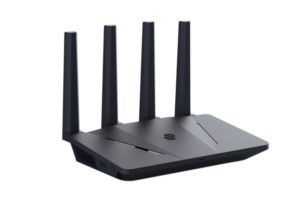The Best VPN Router for Home or Small Business in 2025
Finding the best VPN router requires you to compare options based on performance and VPN support. VPN routers are split into two categories -- routers with exclusive VPN support and routers that support VPNs via specific protocols. We discuss both options in this guide to help you find a VPN router.
A VPN (virtual private network) router can protect every device in your home or small business office, but finding the best VPN router can be a bit daunting with so many options available. Some VPN routers come preinstalled with a VPN service, while others require you to set up a VPN yourself. Also, some routers pair exclusively with one VPN, but others work with multiple services.
If you’re not familiar with VPN and router terminology or don’t want to spend time setting up a VPN on your router, then a router with a preinstalled VPN is a smarter choice. However, if you want to keep costs under control, you may want to consider a router that supports widely used protocols like OpenVPN and WireGuard — these routers should work with most top VPN services.
In this guide, we list five of the best VPN routers on the market. We discuss their performance, their supported protocols or preinstalled VPNs, and other relevant specifications.
-
08/08/2024 Facts checked
We rewrote this article based on recent tests, and we added new options for users who want to prioritize performance and feature sets.
How to Choose the Best VPN Router
When selecting a VPN router, here’s what you should look for:
- Compatibility: Make sure the router you purchase also supports the VPN protocols that your current VPN client offers. In most cases, a router that supports OpenVPN should work with most top VPN apps.
- Wireless standard: Choose a router VPN that offers the latest wireless standard. Currently, that’s 802.11ax (or WiFi 6).
- Frequency: Look for routers that include the 5 GHz band for a faster connection. The 2.4 GHz band offers a stronger and longer range but is generally high-traffic, which translates to lower speeds.
- MU-MIMO: Choose MU-MIMO (multi-user, multi-input, multi-output) routers — these can communicate with multiple devices simultaneously — for better reliability and a stronger signal.
The 5 Best Routers for VPN Connection
| Router: | Price | Frequency | Max Speed | MU-MIMO | Installed VPN |
|---|---|---|---|---|---|
| ExpressVPN Aircove | $189.90 | 2.4 GHz | 1,200 Mbps | -ExpressVPN | |
| ASUS RT-AX1800S | $69.00 | 2.4 GHz, 5 GHz | 1,200 Mbps | -Instant Guard -OpenVPN | |
| ASUS RT-AX3000 | $159.00 | 2.4 GHz, 5 GHz | 3,000 Mbps | -Instant Guard -OpenVPN | |
| TP-Link Archer GX90 | $229.99 | 2.4 GHz, 5 GHz | 4,804 Mbps | -OpenVPN -PPTP -LT2P | |
| Netgear R6400 DD-WRT | $21.92 | 2.4 GHz, 5 GHz | 1,300 Mbps | -OpenVPN -WireGuard |
1. ExpressVPN Aircove — The Best VPN Router
Since ExpressVPN is already installed on it, ExpressVPN Aircove is perfect for beginners and users who are eager to start using a VPN router. You don’t need to flash the router or configure any VPN protocols. Just plug it in and start using the VPN — note that you do need to purchase an ExpressVPN subscription separately. However, you can’t use other VPNs on Aircove.
You can use up to five locations simultaneously by connecting to different VPN servers on different devices. For example, you can connect your mobile devices to a local server to access your online banking portal, while also connecting your TV to a VPN server in a different country to stream geoblocked content.
Router Specifications
The router comes with 512MB of RAM and WiFi 6 support, which can manage speeds of up to 1,200 Mbps. Note that your actual VPN speed will depend on your internet connection, and the speeds may drop slightly once you connect to a VPN server.
The dual-band router lets you choose between 2.4 GHz and 5 GHz frequencies, and it offers coverage of up to 1,600 square feet. We dive deeper into the router’s capabilities and features in our extensive ExpressVPN Aircove review.
ExpressVPN Aircove Pricing & Value
Like most preconfigured routers, ExpressVPN Aircove does come at a premium price. In addition to the one-time cost of $189.90 for the router, you’ll also need an ExpressVPN subscription, which costs $4.99 per month. The router comes with a 30-day free trial of ExpressVPN, so you can try ExpressVPN for free for the first month.
2. ASUS RT-AX1800S — Low-Cost VPN Router
The ASUS RT-AX1800S is an excellent low-cost VPN router compatible with most VPN apps via OpenVPN. It also offers ASUS Instant Guard, a built-in and ready-to-use VPN. It’s not among the top VPNs, but it does the job. The router comes with parental controls, which let you block connected devices, and a scheduling feature that automatically blocks internet access during a chosen time window.
Like other ASUS routers, the RT-AX1800S has great security. It features malicious site blocking, and infected device prevention and blocking. We also love the inbuilt router security assessment tool that automatically finds ways to configure the router to improve security. After completing a scan, the tool links you to various sections to change security settings so you don’t have to find them manually.
3. ASUS RT-AX3000 — High-Performance VPN Routers
The ASUS RT-AX3000 (and the RT-AX58U variant) come with ASUS Instant Guard preinstalled, so you can quickly encrypt your internet connection as soon as you set up the router.
That said, it’s also compatible with other providers via OpenVPN. The WiFi router offers top-notch WiFi 6 performance and speeds of up to 3,000 Mbps. It’s a perfect router for most homes and medium-sized office spaces.
You get plenty of controls with the ASUS RT-AX3000, including QoS controls to prioritize certain service types (for example streaming services like Netflix and BBC iPlayer) and parental controls that help you schedule internet access and block adult content.
The router doesn’t include a modem, though — you’ll need to connect the ASUS RT-AX3000 to an existing broadband modem or router to access the internet.
4. TP-Link Archer GX90 — Tri-Band VPN Router
The TP-Link Archer GX90 is the most eye-catching router on this list. The red-black color scheme and eight pointed antennas give this gaming router an attractive bulk. The router offers a built-in server and support for VPN providers via OpenVPN, PPTP and LT2P. This means you can set it up with top VPNs, such as NordVPN, Surfshark and ExpressVPN.
The Archer GX90 is packed with advanced features and capabilities. For example, you can get extensive coverage throughout your property thanks to TP-Link’s OneMesh technology. The GX90 uses it to form a large mesh network with TP-Link routers and range extenders. You also get a dedicated 4,804 Mbps (5 GHz) game band, along with the 574 Mbps (2.4 GHz) and 1,201 Mbps (5 GHz) bands.
5. Netgear R6400 DD-WRT — Feature-Rich VPN Router
Netgear is one of the most popular router brands, and the R6400 does Netgear’s reputation justice. It offers decent speeds and reliability, making it a great router for almost any purpose, including gaming and streaming. The router is compatible with Amazon Echo, so you can control your router via voice commands.
You can set up any popular VPN on this router, including NordVPN, Surfshark and ExpressVPN. The ASUS website has an extensive guide on how to configure the VPN on your router, but be sure to check the VPN protocol your VPN service provider offers — you’ll need this information when configuring it.
Our Methodology: How We Chose the Best VPN Routers
When looking for the best VPN routers, we assess the following factors during our tests:
VPN Support
We look for routers that support the top VPN services on the market. Many VPN routers — especially plug-and-play routers — offer a single VPN service that comes preconfigured. This is great if you want to stick with the same VPN provider and don’t want the hassle of setting it up.
That said, they aren’t a great choice for users who already use a different VPN service or want the flexibility to choose their desired VPN. That’s why we also look for routers that support VPNs via protocols like OpenVPN and WireGuard.
Speed
Speed is the most important aspect when selecting a router. You might have a fast broadband connection, but unless your router offers equal or greater speeds, you won’t be able to utilize your connection’s full potential.
Ease of Use
Setting up a VPN on a router can seem daunting, especially if you’ve never used VPNs before and aren’t familiar with the terminology. We prioritize routers that simplify the process of setting up a VPN or offer a built-in VPN.
How to Set Up a VPN Router
The process for setting up a VPN differs based on the router you’re using. Here are some general guidelines for how to set up a VPN on your router:
- Sign Up for a VPN: If you’d like to choose your preferred VPN service instead of using one that comes preconfigured on your new router, your first step is to sign up for a VPN service — we recommend NordVPN.
- Configure the Router: Log in to your router firmware and look for the VPN section of the router’s settings. The placement of this option depends on the router’s brand and firmware. We explain the process in greater detail, and we provide options for popular router brands and firmware in our extensive guide to setting up a VPN on a router.
- Enable the VPN: Once you’ve configured the router, enable the VPN. Your internet traffic should now be encrypted.
Pros & Cons of VPN Routers
VPN routers are excellent for beginners or people who need to start using a VPN quickly, but they also come with a few downsides. Let’s talk about the advantages and disadvantages of VPN routers.
Advantages of VPN Routers
- Easy setup: Routers that come preconfigured with a VPN are perfect for beginners. You can buy a router like the ExpressVPN Aircove, which offers a ready-to-use VPN service, and start using the VPN as soon as you plug in the router — no manual VPN setup is necessary.
- No cap on number of connections: Instead of installing the VPN app on multiple devices at home or the office, just set up the VPN on your router so it’s available for all the devices that are connected to the router. Installing the VPN also helps you bypass the simultaneous connections limit imposed by services like NordVPN and ExpressVPN.
- Protection for devices that lack VPN support: Certain devices, like some smart TVs, don’t natively support VPNs. Setting up the VPN on your router ensures that these devices can access benefits such as online security and the ability to bypass geoblocks.
Disadvantages of VPN Routers
- Complex setup: Not all VPN routers come with a VPN preconfigured. Some offer support for VPN services only via protocols like OpenVPN, WireGuard and PPTP. These routers require you to manually input details into the router’s firmware to enable the VPN. The process may feel a bit daunting to first-time VPN users.
- Single point of failure: When the VPN router encounters problems or goes offline, the connections across all of your devices are no longer encrypted. This puts your security and privacy at risk, especially if you’re in the middle of sensitive tasks like online banking.
Final Thoughts
VPN routers are a great way to create a single, secure point of internet access for all devices in your home or small business office. While there are plenty of options on the market, not all have equal performance or a great value-to-price ratio. ExpressVPN Aircove is the best VPN router around. However, based on your needs, you may prefer one of the other routers in this guide.
Have you ever used a VPN router? Did you choose a router with a preconfigured VPN? If not, how complex was the setup process? Let us know in the comments below, and as always, thank you for reading.
FAQ: Best Router With VPN
ExpressVPN Aircove is the best VPN router overall. However, if you want to use a different VPN on your router, consider routers like ASUS RT-AX1800S and ASUS RT-AX3000.
Most routers with a VPN are worth it provided that you find one that meets your needs. For example, if you need to start using the VPN on your router quickly, choose one with a preconfigured VPN service so you can skip the complex setup process. On the other hand, if you want the flexibility to choose your own VPN service, you’ll need to invest time in setting up the VPN yourself.
Yes, many routers have a built-in VPN, but not all of them do. Some routers offer a preinstalled VPN service, while others allow you to configure VPN services via specific VPN protocols.
All VPNs that support OpenVPN will work with NordVPN. Other than this, the router’s specs — including the processor and bands — will determine the overall performance. For example, a router like the TP-Link Archer GX90 might offer the best performance with NordVPN because of its excellent specs and capabilities.













